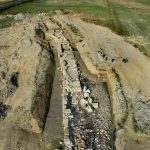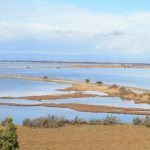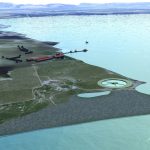Narbo Martius

loading map - please wait...
Historical background
By C. Sanchez, N. Carayon
Narbo Martius, now Narbonne in the south of France, was founded in 118 BC by Cn. Domitius Ahenobarbus at the crossroads of the Via Domitia and the Gallic isthmus which offers an easy route towards the Atlantic Ocean. This Colonia Narbo Martius is the first Roman colony outside of Italy. Both Pompeius’s and Julius Caesar’s armies stayed in Narbonne. Cicero (Pro Fonteio, 13) mentioned the city as “a watch-tower of the Roman people”. In 46-45 BC, a new colony was founded here by Caesar with the veterans of the tenth legion. Narbo Martius became the Colonia Julia Narbo Martius. Augustus also came to Narbonne (c. 27 BC) to reorganize the Roman province of Gallia Narbonensis. In 22 BC, Narbonne, now called Colonia Julia Paterna Narbo Martius, became the capital of the province. Narbonne then prospered and kept a political and economic ascendancy in Gaul. Important changes in the city are noticed at the beginning of third century AD when the peripheral areas of the urban centre are abandoned. After the administrative reorganization of the provinces of the Roman Empire by the Emperor Diocletian (AD 284-305), Narbonne becomes part of the Diocesis Viennensis and the previous Provincia Gallia Narbonensis is divided into three provinces, Narbonensis Prima, Narbonensis Secunda and Viennensis. Narbonne administrates just the Narbonensis Prima.
The book of Michel Gayraud, published in 1981 (Gayraud 1981) remains an important reference work on the history of Narbonne.
Archaeological background
By N. Carayon
All around the fluvio-lagoonal harbour of Narbonne, numerous and scattered archaeological sites were found since the 19th century and dated from the Bronze Age until the modern period. The publication in 2002 of the Carte archéologique de la Gaule for the Narbonne area attempts to make an overview of the archaeological discoveries (CAG 11/1). Since 2005, a collective project of research, now coordinated by Corinne Sanchez from the French CNRS, focuses on the ancient ports of Narbonne (Sanchez and Jézégou 2011; Sanchez and Jézégou 2014).
During the 2nd century BC and before the foundation of the Colonia Narbo Martius in 118 BC, the oppidum of Montlaurès, 4 Km north-east of Narbonne, is probably the major site of the area and the hub of the trade between indigenous and the Italian merchantmen. All around the lagoon, a lot of small sites are known from archaeological data. They seem to be rural settlements principally devoted to the exploitation of the local resources, some focused on maritime activities and land based. All these sites, like Montlaurès, are occupied until the middle of the first century BC and are characterised by the predominance of ceramics from Italy: Italic and Campanian wares (Sanchez 2009).
In the Early Imperial period, there are important changes in the Narbonne area. Most of the sites of the 2nd and first part of the 1st centuries BC are abandoned and some new sites settled (Sanchez, Ginouvez, and Kotarba 2011). At that period, the port system of Narbo Martius seems to be organized in three principal components: (1) the urban port in a hypothetical Roman Canal de la Robine; (2) the new artificially embedded Aude River between Narbonne and the lagoon; and (3) secondary ports or landing stages around the lagoon, e.g. La Nautique, and on the islands of the lagoon such as Saint-Martin.
Geomorphological background
By N. Carayon, F. Salomon
The harbour system of ancient Narbo Martius, which is located around the current city Narbonne in the south of France, is shaped by a fluvio-lagoonal geomorphological unit. The upper part of this unit corresponds to the alluvial plain of the River Aude, where the city of Narbonne was founded. The lower part of this unit is formed by the lagoons of Narbonne limited by the Massif de la Clape at the North and Massif des Corbières at the south: principally the lagoon of Bages-Sigean to the south, the lagoon of the Ayrolles and the lagoon of Gruissan to the south-east. Today, these three lagoons are separated from the sea by a barrier beach running from Port-la-Nouvelle in the south to Gruissan in the north and cut by three inlets, from south to north, the Port-la-Nouvelle inlet, the Vieille-Nouvelle inlet and the Gruissan inlet.
According to the ancient sources, the city of Narbonne was located at the mouth of the Aude river but it is no longer the case. Very considerable changes transformed the landscape of the area. The most important was the undated avulsion of the river which now flows to the north of the Massif de la Clape and exits into the sea at Vendres. The Aude river now flows at a distance from Narbonne and the only link between the city and the sea is actually the artificial Canal de la Robine which runs across the city and the lagoon from the Aude river at Sallèles d’Aude in the north to the sea in the south.
The second very important change of the landscape is the progradation of the coast since antiquity, principally due to the alluvium transported by the Aude river. This geomorphological process has been studied by different scholars but the location of the coast during the Roman period is still unclear (Ambert 2011; Ambert 2000; Cavero 2010). This is one of the aims of the collective project of research called “Les ports antiques de Narbonne”, headed by Corinne Sanchez from the French CNRS. Two PhD students are currently studying the paleogeography of the fluvio-lagoonal area of Narbonne (Tiphaine Salel, University of Montpellier 3) and the geoarchaeology of the ancient ports of Narbonne (Camille Faïsse, University of Montpellier 3).
Importance in the Roman harbour network
By N. Carayon
The geographical location of the Narbonne area at the mouth of the Aude River makes the city an important nodal point between Italy and Spain and between the Mediterranean Sea and Atlantic Ocean through the Gallic Isthmus. These links are improved during Roman period by the construction of the Via Domitia and the Via Aquitania. The importance of the port and its links is underlined by the ancient authors, notably Strabo who mentions the port as the most important of the region (Geography, IV, 1, 6) and as the emporium of all Gaul (Geography, IV, 1, 12).
References
- Ambert, Paul. 2000. “Narbonne antique et ses ports, géomorphologie et archéologie, certitudes et hypothèses.” Revue Archéologique de Narbonnaise 33 (1): 295–307.
- ———. 2011. “Potentiel et contraintes du cadre géologique régional pour l’aménagement de Narbonne.” In C. Sanchez, M.-P. Jézégou (ed.), Espaces littoraux et zones portuaires de Narbonne dans l’Antiquité, 13–20. Monographies d’archéologie méditerranéenne 28. Lattes.
- Carte archéologique de la Gaule 11/1. 2002. Narbonne et le Narbonnais. Les Editions de la MSH.
- Cavero, Julien. 2010. “Paléogéographie des étangs narbonnais d’après les sources cartographiques anciennes.” Géocarrefour, no. 1 (May): 29–40.
- Gayraud, Michel. 1981. Narbonne antique: des origines à la fin du IIIe siècle. Revue archéologique de Narbonnaise 8. Diffusion de Boccard.
- Sanchez, Corinne. 2009. Narbonne à l’époque tardo-républicaine. Chronologies, commerce et artisanat céramique. Revue Archéologique de Narbonnaise, Supplément 38.
- Sanchez, Corinne, Olivier Ginouvez, and Jérôme Kotarba. 2011. “La question des établissements littoraux en relation avec le système portuaire. L’apport des prospections ‘Sud-Narbonnais’ et des recherches récentes.” In C. Sanchez and M.-P. Jézégou (éd.), Espaces littoraux et zones portuaires de Narbonne et sa région dans l’Antiquité, 41–66. Lattes.
- Sanchez, Corinne, and Marie-Pierre Jézégou, eds. 2011. Espaces littoraux et zones portuaires de Narbonne et sa région dans l’Antiquité. Monographie d’archéologie méditerranéenne 28. Publications de l’UMR 5140 du CNRS.
- ———. , eds. 2014. Les ports antiques de Narbonne. Parc naturel régional de la Narbonnaise en Méditerranée. Les Carnets du Parc 15. Narbonne.




